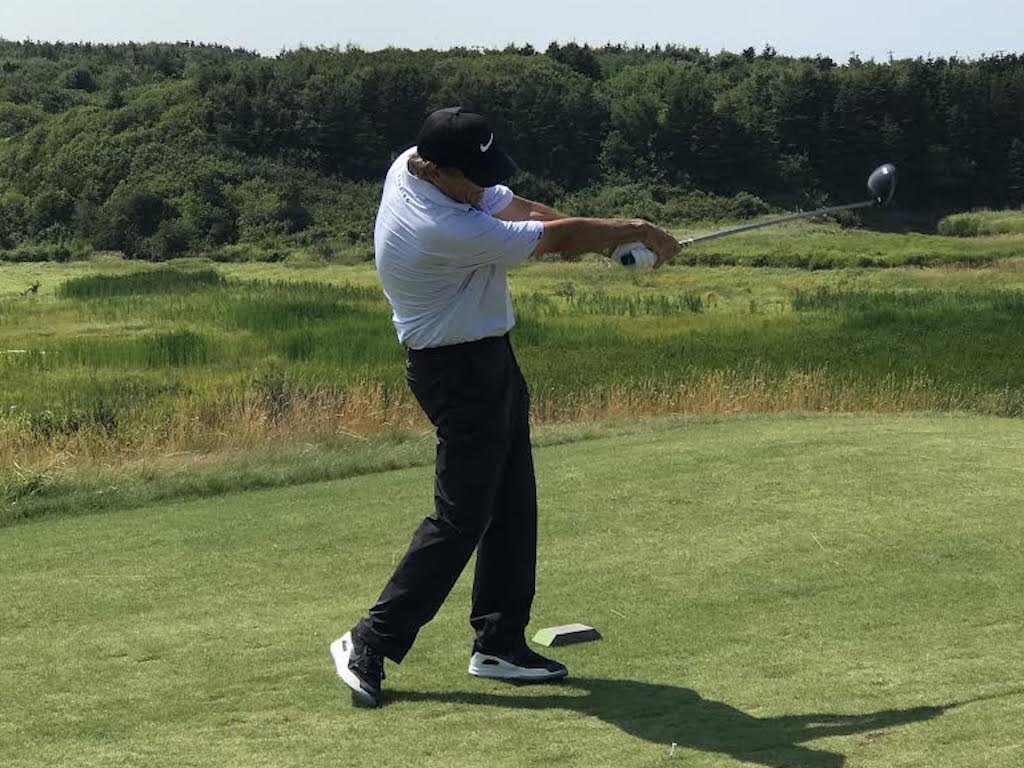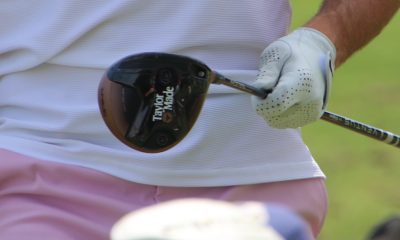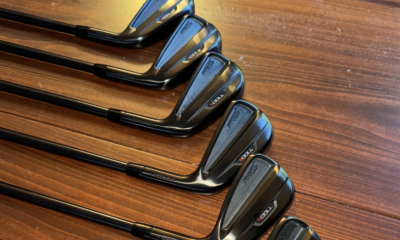Instruction
Changing your golf swing? Consider this before you do

Golfers I have taught over the years have an almost uncanny ability to put the golf club on the ball (to varying degrees, of course). I have seen well-hit shots from an incredibly wide variety of positions. I’ve seen closed faces, open faces, steep swings, flat swings, outside-in paths, inside-out paths, slow and fast swings, strong grips and weak grips ALL hit the golf ball solidly at times. How? Well, thinking about this may very well help your swing, especially before you decide to change something in it. Let’s take a look at a few examples to explain.
Strong Grips/Closed Clubfaces
We’ll start with the example of a strong grip that tends to get the clubface quite closed to the arc in the swing and at the top of the swing. If that is left alone in the downswing, the shots are very predictable: low and left (for a right-hander), sometimes barely getting off the ground. But many golfers hit the ball in the air and straight with a strong grip; in fact, many hit high blocks to the right. How? Well, they open the face on the way down and usually “hold on” through impact. They adapt to the closed clubface to make it work, and that’s the point here.
Now, if they reach good impact consistently like a Dustin Johnson, Graham McDowell and several others do with a closed clubface, we have no problem. But often club golfers do not; in fact, many slice and top the ball from a shut face at the top. They do so because opening a closed face is a very shallowing move and prevents one from releasing the club properly (it’s a power outage as well). Functionally, however, opening a shut is far better than releasing it from there, for obvious reasons. If the trail hand pronates, the face goes from closed to really closed. So golfers simply learn to open it.
So along comes some well-meaning friend who says your clubface is really closed at the top. You look at many great players, and sure enough, your face is clearly shut. So you correct it. What happens next is also very predictable: high and very right, and very thin with many topped shots. Why? Because you only corrected part of the problem. You fixed the shut face, but now you’ve taken a square clubface and massively opened it as a force of habit. You have ingrained that move into your swing because you had to open your old, shut clubface in the downswing. Correcting only ONE thing made your swing worse. Your swing is now dysfunctional.
That’s why if you commit to one change for the sake of improvement or consistency, you have to commit to both changes. If you don’t, you’ll get worse… not better.
Steep Swings
Here’s another: many amateur players start the downswing with the golf club far too steep. Maybe it’s over the top, maybe not (you can be just as steep from inside the ball). But when the golf club is too vertical in transition, it can result in any one of a number of impact mistakes: namely fat, slices and toe hits. So the idea of “flattening the transition” (good idea) becomes your priority, but there’s always a catch. Most experienced golfers correct steep through one of a few different ways listed below:
- Raising the hands (standing the club up) to avoid fat shots
- Tilting the torso back or away from the target to avoid opening the face
- Sending the hands away from the body to avoid toes hits
- Raising the swing center
You get the picture here. You learn to get the club on a better plane (flatter with the butt of the grip pointed more at the golf ball), but you’ll likely still have one of the “fit-in” moves left into impact. So a flatter club, which is by far a better way to square the face, might result in a shank if you’re used to sending your hands away from your body to avoid a toe hit. Raising the hands might top. Tilting the torso back away might hit shallow fats or tops. So you fixed the steep transition, but your impact is worse! Again, you’re dysfunctional.
Remember, if you commit to one change, you MUST commit to both.
Weak Grips/Over-The-Top
One more: Golfers who start out with a weak grip (as most do) slice. So as a reaction, they come over the top and swing outside-in. So they fix the grip, and of course, the result is predictable. They pull the ball, generally low and left (for right-handers). You get the pattern here. They need to learn a new swing direction, and on and on.
The lesson is clear; a single correction of a swing issue can be sufficient, but in my experience, two corrections must be tackled for long-term improvement. What to correct first? Well, you’d have to consult with your teacher or coach. As a rule, I try to get better impact first if I can get someone there from where their swing is now. Some other teachers may prefer a different sequence, but I think they’d all agree that a two-part correction is ultimately in the works.
I’ve always believed that teachers can disagree widely on the prescription, but they should be pretty much in unison regarding the diagnosis. Learn the swing flaw AND your reaction to it before you decide to make a swing change.
- LIKE64
- LEGIT8
- WOW0
- LOL3
- IDHT1
- FLOP3
- OB2
- SHANK13
Instruction
The Wedge Guy: The easiest-to-learn golf basic

My golf learning began with this simple fact – if you don’t have a fundamentally sound hold on the golf club, it is practically impossible for your body to execute a fundamentally sound golf swing. I’m still a big believer that the golf swing is much easier to execute if you begin with the proper hold on the club.
As you might imagine, I come into contact with hundreds of golfers of all skill levels. And it is very rare to see a good player with a bad hold on the golf club. There are some exceptions, for sure, but they are very few and very far between, and they typically have beat so many balls with their poor grip that they’ve found a way to work around it.
The reality of biophysics is that the body moves only in certain ways – and the particulars of the way you hold the golf club can totally prevent a sound swing motion that allows the club to release properly through the impact zone. The wonderful thing is that anyone can learn how to put a fundamentally sound hold on the golf club, and you can practice it anywhere your hands are not otherwise engaged, like watching TV or just sitting and relaxing.
Whether you prefer an overlap, interlock or full-finger (not baseball!) grip on the club, the same fundamentals apply. Here are the major grip faults I see most often, in the order of the frequency:
Mis-aligned hands
By this I mean that the palms of the two hands are not parallel to each other. Too many golfers have a weak left hand and strong right, or vice versa. The easiest way to learn how to hold the club with your palms aligned properly is to grip a plain wooden ruler or yardstick. It forces the hands to align properly and shows you how that feels. If you grip and re-grip a yardstick several times, then grip a club, you’ll see that the learning curve is almost immediate.
The position of the grip in the upper/left hand
I also observe many golfers who have the butt of the grip too far into the heel pad of the upper hand (the left hand for right-handed players). It’s amazing how much easier it is to release the club through the ball if even 1/4-1/2″ of the butt is beyond the left heel pad. Try this yourself to see what I mean. Swing the club freely with just your left hand and notice the difference in its release from when you hold it at the end of the grip, versus gripping down even a half inch.
To help you really understand how this works, go to the range and hit shots with your five-iron gripped down a full inch to make the club the same length as your seven-iron. You will probably see an amazing shot shape difference, and likely not see as much distance loss as you would expect.
Too much lower (right) hand on the club
It seems like almost all golfers of 8-10 handicap or higher have the club too far into the palm of the lower hand, because that feels “good” if you are trying to control the path of the clubhead to the ball. But the golf swing is not an effort to hit at the ball – it is a swing of the club. The proper hold on the club has the grip underneath the pad at the base of the fingers. This will likely feel “weak” to you — like you cannot control the club like that. EXACTLY. You should not be trying to control the club with your lower/master hand.
Gripping too tightly
Nearly all golfers hold the club too tightly, which tenses up the forearms and prevents a proper release of the club through impact. In order for the club to move back and through properly, you must feel that the club is controlled by the last three fingers of the upper hand, and the middle two fingers of the lower hand. If you engage your thumbs and forefingers in “holding” the club, the result will almost always be a grip that is too tight. Try this for yourself. Hold the club in your upper hand only, and squeeze firmly with just the last three fingers, with the forefinger and thumb off the club entirely. You have good control, but your forearms are not tense. Then begin to squeeze down with your thumb and forefinger and observe the tensing of the entire forearm. This is the way we are made, so the key to preventing tenseness in the arms is to hold the club very lightly with the “pinchers” — the thumbs and forefingers.
So, those are what I believe are the four fundamentals of a good grip. Anyone can learn them in their home or office very quickly. There is no easier way to improve your ball striking consistency and add distance than giving more attention to the way you hold the golf club.
More from the Wedge Guy
- The Wedge Guy: Golf mastery begins with your wedge game
- The Wedge Guy: Why golf is 20 times harder than brain surgery
- The Wedge Guy: Musings on the golf ball rollback
- LIKE85
- LEGIT13
- WOW6
- LOL1
- IDHT0
- FLOP4
- OB1
- SHANK8
Instruction
Clement: Stop ripping off your swing with this drill!

Not the dreaded headcover under the armpit drill! As if your body is defective and can’t function by itself! Have you seen how incredible the human machine is with all the incredible feats of agility all kinds of athletes are accomplishing? You think your body is so defective (the good Lord is laughing his head off at you) that it needs a headcover tucked under the armpit so you can swing like T-Rex?
- LIKE0
- LEGIT2
- WOW2
- LOL0
- IDHT0
- FLOP0
- OB0
- SHANK2
Instruction
How a towel can fix your golf swing

This is a classic drill that has been used for decades. However, the world of marketed training aids has grown so much during that time that this simple practice has been virtually forgotten. Because why teach people how to play golf using everyday items when you can create and sell a product that reinforces the same thing? Nevertheless, I am here to give you helpful advice without running to the nearest Edwin Watts or adding something to your Amazon cart.
For the “scoring clubs,” having a solid connection between the arms and body during the swing, especially through impact, is paramount to creating long-lasting consistency. And keeping that connection throughout the swing helps rotate the shoulders more to generate more power to help you hit it farther. So, how does this drill work, and what will your game benefit from it? Well, let’s get into it.
Setup
You can use this for basic chip shots up to complete swings. I use this with every club in my bag, up to a 9 or 8-iron. It’s natural to create incrementally more separation between the arms and body as you progress up the set. So doing this with a high iron or a wood is not recommended.
While you set up to hit a ball, simply tuck the towel underneath both armpits. The length of the towel will determine how tight it will be across your chest but don’t make it so loose that it gets in the way of your vision. After both sides are tucked, make some focused swings, keeping both arms firmly connected to the body during the backswing and follow through. (Note: It’s normal to lose connection on your lead arm during your finishing pose.) When you’re ready, put a ball in the way of those swings and get to work.

Get a Better Shoulder Turn
Many of us struggle to have proper shoulder rotation in our golf swing, especially during long layoffs. Making a swing that is all arms and no shoulders is a surefire way to have less control with wedges and less distance with full swings. Notice how I can get in a similar-looking position in both 60° wedge photos. However, one is weak and uncontrollable, while the other is strong and connected. One allows me to use my larger muscles to create my swing, and one doesn’t. The follow-through is another critical point where having a good connection, as well as solid shoulder rotation, is a must. This drill is great for those who tend to have a “chicken wing” form in their lead arm, which happens when it becomes separated from the body through impact.
In full swings, getting your shoulders to rotate in your golf swing is a great way to reinforce proper weight distribution. If your swing is all arms, it’s much harder to get your weight to naturally shift to the inside part of your trail foot in the backswing. Sure, you could make the mistake of “sliding” to get weight on your back foot, but that doesn’t fix the issue. You must turn into your trial leg to generate power. Additionally, look at the difference in separation between my hands and my head in the 8-iron examples. The green picture has more separation and has my hands lower. This will help me lessen my angle of attack and make it easier to hit the inside part of the golf ball, rather than the over-the-top move that the other picture produces.


Stay Better Connected in the Backswing
When you don’t keep everything in your upper body working as one, getting to a good spot at the top of your swing is very hard to do. It would take impeccable timing along with great hand-eye coordination to hit quality shots with any sort of regularity if the arms are working separately from the body.
Notice in the red pictures of both my 60-degree wedge and 8-iron how high my hands are and the fact you can clearly see my shoulder through the gap in my arms. That has happened because the right arm, just above my elbow, has become totally disconnected from my body. That separation causes me to lift my hands as well as lose some of the extension in my left arm. This has been corrected in the green pictures by using this drill to reinforce that connection. It will also make you focus on keeping the lead arm close to your body as well. Because the moment either one loses that relationship, the towel falls.


Conclusion
I have been diligent this year in finding a few drills that target some of the issues that plague my golf game; either by simply forgetting fundamental things or by coming to terms with the faults that have bitten me my whole career. I have found that having a few drills to fall back on to reinforce certain feelings helps me find my game a little easier, and the “towel drill” is most definitely one of them.
- LIKE12
- LEGIT2
- WOW2
- LOL0
- IDHT0
- FLOP2
- OB0
- SHANK8
-

 19th Hole1 week ago
19th Hole1 week agoDave Portnoy places monstrous outright bet for the 2024 Masters
-

 19th Hole2 weeks ago
19th Hole2 weeks agoThings got heated at the Houston Open between Tony Finau and Alejandro Tosti. Here’s why
-

 19th Hole1 week ago
19th Hole1 week agoTiger Woods arrives at 2024 Masters equipped with a putter that may surprise you
-

 19th Hole2 weeks ago
19th Hole2 weeks agoReport: Tiger Woods has ‘eliminated sex’ in preparation for the 2024 Masters
-

 19th Hole3 days ago
19th Hole3 days agoTwo star names reportedly blanked Jon Rahm all week at the Masters
-

 19th Hole3 days ago
19th Hole3 days agoNeal Shipley presser ends in awkward fashion after reporter claims Tiger handed him note on 8th fairway
-

 19th Hole2 weeks ago
19th Hole2 weeks agoAddiction, spinal fusion, and scam artists – Everything Anthony Kim revealed in candid interview with David Feherty
-

 19th Hole2 weeks ago
19th Hole2 weeks agoAnthony Kim says doctors told him that he ‘may not have much time left’ ahead of LIV return

























Olle Eriksson
Oct 21, 2019 at 5:07 am
Great article. Most of it makes sense to me. But what I’m left wondering is what the correct 2nd change to flattening the shaft, if the list of things you mention are the incorrect adaptions?
Commoner
Jul 16, 2018 at 3:28 pm
Based on previous exposure to Clark’s teaching, it’s my opinion he has the ability to phrase points or express himself in a way that the ‘average’ golfer can understand concept and method. What really impresses is his acceptance of the pupil as a real live being with assorted quirks, habits, limitations, and traits. This is so much better than trying to pound that square peg into the round hole.
Lm
Jul 15, 2018 at 9:58 pm
is that you, Clampett? Lmao
E
Jul 15, 2018 at 11:46 am
I get the broader point that things work in systems but my god why does this have so many technical and confusing specifics
ogo
Jul 15, 2018 at 4:14 pm
…. so you will seek help from an instructor… rather than attempting to do it subjectively not knowing what you are really doing right or wrong…!!
JK
Jul 16, 2018 at 2:28 pm
If you want a K.I.S.S. solution stop golfing for two weeks… and then sell your clubs on ebay. That should solve your swing problems!